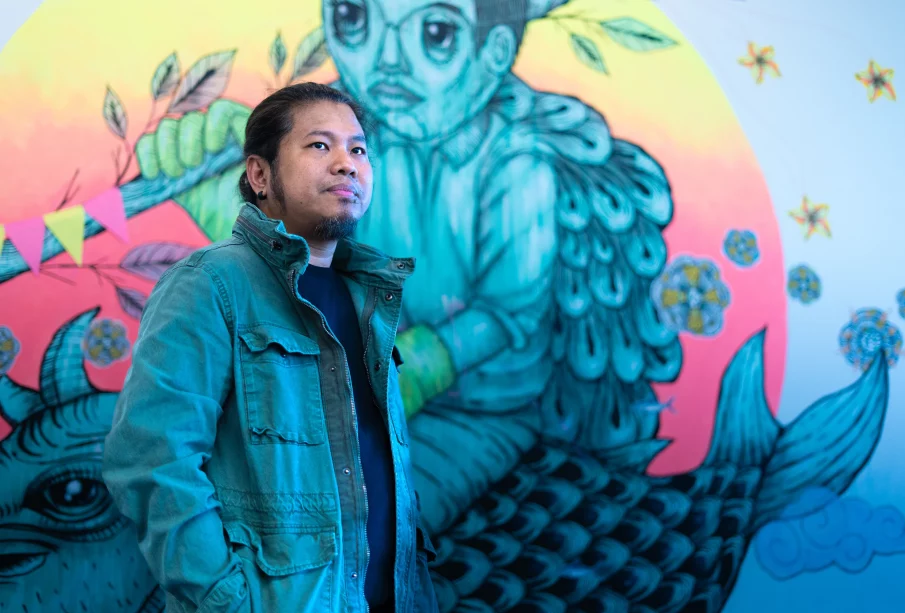Interview with an artist: Patrick Fernandez
With pieces informed by his experiences, folklore, and traditions in the Philippines, Patrick Fernandez is a contemporary visual artist based in Regina. He opened his exhibition to the public this year during his residency at the Mackenzie Art Gallery. Entitled Sumasayaw sa Indak ng mga Alon (Dancing in the Rhythm of the Waves), the exhibition is made up of large murals depicting Filipino culture and his struggles with displacement.
Growing up in a dysfunctional family, Fernandez did not know the meaning of home until recently. He remembers his childhood to be made up of packing his things and moving to a different house almost every six months.
“It was a chaotic life and my father couldn’t sustain a job. I hated moving. It must have been twenty times that we moved,’’ he said. The one constant thing for young Fernandez was receiving a local comic book series from his mother. He spent most of his free time tracing and imitating comic artists; it was the beginning of his love for the arts.
Unfortunately, he was discouraged to pursue the fine arts by a lack of familial support and money. Additionally, he lived in Pangasinan and the countryside was hours away from a university that offered the degree. He was forced to divert from his dreams and ended up studying Electronic and Communication Engineering. Finding ways to still be immersed in the arts, he joined student clubs and art communities.
“I was part of different organizations as an events coordinator; we built up many small artists,” Fernandez recalled. “I wasn’t a full-time artist then but I was able to leave an impression this way and it taught me other ways to be an artist.’’
His life in the fishing region bleeds heavily into this installation; illustrations of fish and corals create a wave around the room. – Lee Lim
Much to his family’s dismay, he left the engineering program and dedicated his energy towards establishing himself in the art scene. He would often travel out of province just to attend exhibitions in the capital city. “I didn’t have disposable income and I had to go to the city to sell my art. It was hard coming home without a sell but I got my name out this way.’’
After gambling time and money, Fernandez’ works were soon shown all around Asia. In 2017, he found himself moving again, this time to Canada’s Land of Living Skies. He was married with a kid at the time and struggled with juggling his art and finding a day job in Regina.
“People wouldn’t acknowledge someone without ‘Canadian’ experience,” Fernandez reminisced. “I was sending my art back to the Philippines to make money and had multiple exhibitions lined up but it just became too expensive.’’
Having to rebuild from scratch, he went to every exhibition he could to introduce himself to Saskatchewan’s art community. “Since I was new, they weren’t familiar with my work and the POC or immigrant narrative wasn’t as important back then,’’ Fernandez claims. Luckily, he was given funding for a studio by his loyal collectors and was able to propel his career once again as an artist in Regina.
Visitors can experience his most recent work at the Mackenzie Art Gallery until Feb 8, 2026. His installations allude to his hometown in Pangasinan, which visitors become immediately immersed in upon entering the gallery. Strong hues of blue, yellow, green, and orange illuminate the space, creating an atmosphere that represents the tropical shores of the province.
His life in the fishing region bleeds heavily into this installation; illustrations of fish and corals create a wave around the room. Spectators will find a large sketch of a man riding a creature with the head of a fish and the body of a water buffalo which symbolizes resilience and strength to keep pushing through the harsh tides of life. In the middle of the exhibition, triangle-shaped coloured papers and markers are laid on the table for visitors to create their own banderitas, which are colourful decorative flags that are commonly found in festivals.
Another interactive element for visitors to enjoy involves peeking into the wooden house panels hung on the walls. Inside them are thought-provoking proverbs that elders would use to inspire or comfort. These are phrases young Fernandez heard in sermons from his grandparents. Now grateful for these words of wisdom, he hopes to pass these traditions down to the next generation of Filipino-Canadians. While the elements used in the installation are based in his culture, he doesn’t intend for the message to be exclusive. “There are many people who are coping with loss and displacement, and my work shows that growth and change are universal,’’ he said.
Working with heavy themes can be exhausting and it’s a marvel that Fernandez’ work leaves one feeling hopeful. When asked why he chooses to centre joy in his work, he said, “We have always found something to celebrate even in hardship. Filipinos are happy people and that’s what I want to present in my work.’’
There are many people who are coping with loss and displacement, and my work shows that growth and change are universal – Patrick Fernandez
Fernandez found that portraying the negative side of things simply became a shock factor that would make the audience hesitant to engage with his art. “[It] built a wall,” he said. “People get fearful of commenting on your work because of its sensitive topic.’’
With over 25 years of artist experience under his belt, Fernandez continues to reflect on his journey and looks cheerfully ahead to the future, where he intends for his next projects to be larger than the last. “I want to make something big and sculptural, something like the jeepney, bahay kubo, or a boat,’’ he teased.
Finally able to put down roots and raise a family in Regina, he hopes to represent the Filipino culture and provide comfort through telling his story of resiliency. “I dream of one Filipino artwork in every Filipino home,” he shared.









